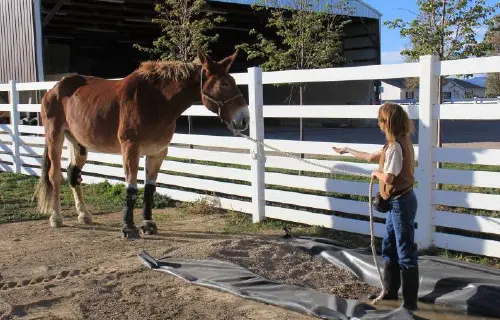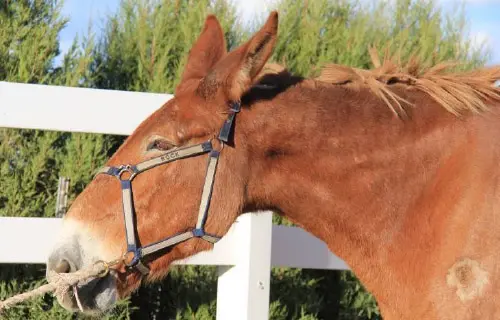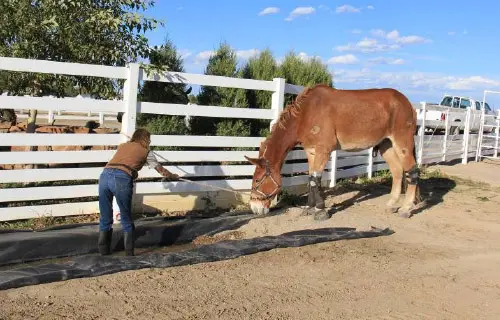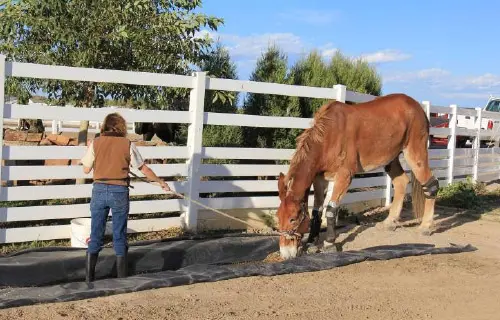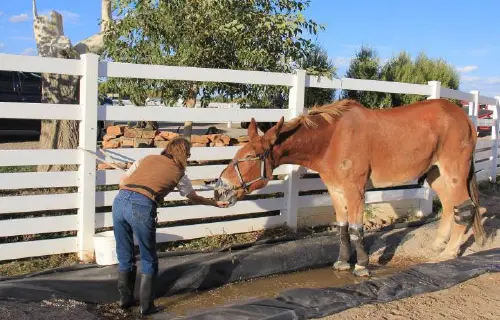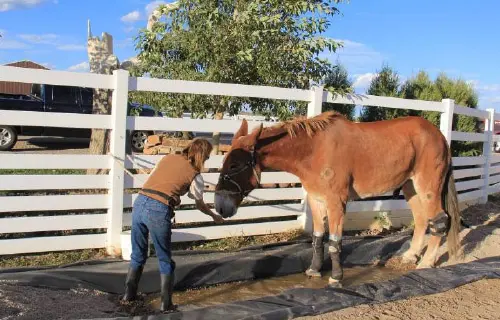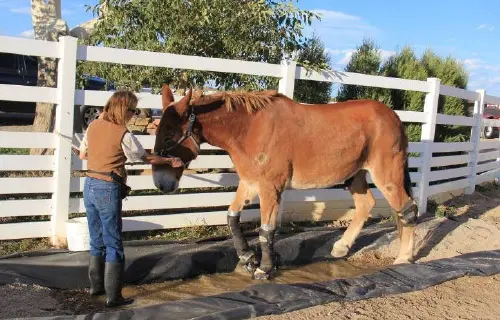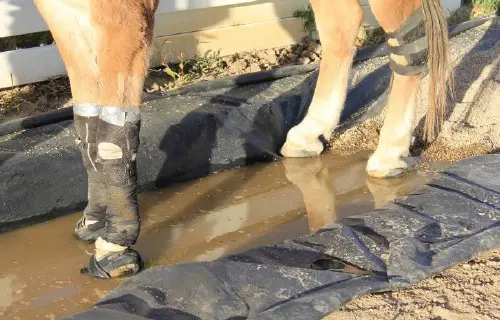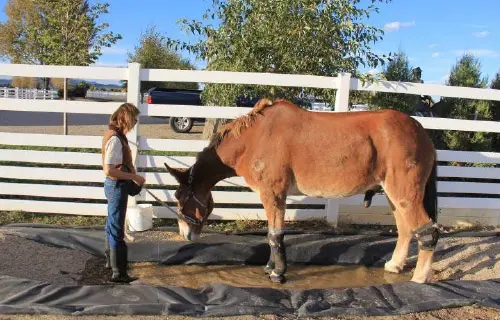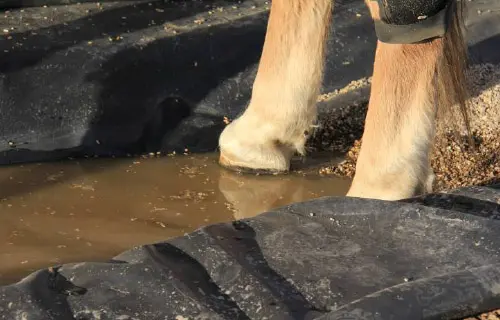2011 – Rock & Roll – 10-14-16-11 – LAMINITIS
10/14/11: The saga of Rock continues. We had a powwow with our support team on Friday (Me, Joanne massage therapist, Dave Miller DVM, Greg Farrand DVM, Dave McClain Rock’s chiropractor, Kevin Haussler CSU chiropractor, Chad) and it was decided that Rock’s laminitis in front was causing a lot of the problems in his back legs. The best therapy would be to ice pack his feet 2-5 times per day. This posed a challenge if we were to put his feet in buckets of ice.
10/15/11: We tried bags of ice on his feet this morning, but that was kind of a hassle, so Chad and Steve spent the afternoon building an ice ditch for him so we could ice all four feet at the same time. We knew there would be a training issue, so we kept the water level a little shallow this time, It took about 45 minutes to convince Rock it was okay to stand in the icy water in the ditch…and not climb up the side…or go around it! He stood in the water for about 20 minutes, but after that is was past feeding time and he was ready to climb out. We will do more tomorrow. I was so proud of him and of the fact that he trusts me enough now to do ask I ask without much trouble at all. What a good boy!
After being iced twice today, he does seem to have improved more than I would have thought. He was standing in a hunched position yesterday with both knees buckled in front. Today after the first icing, he was standing with both knees locked during the icing with some weight shifting from leg to leg, but after the second time he is once again standing with his knees straightened out and seems pain free this evening. It must have felt really good to him and I am so grateful to Chad and Steve for their interest and creativity in dealing with these kinds of issues. They really care!!
The second icing was a 45 minute exercise in training to get into the ditch NICELY. Once he got in, he stood well for about 20 minutes and then seemed to want to walk out. Of course, it was feeding time, so that may have had something to do with it, but he did stay in for 25 minutes.
10/16/11: Rock was iced twice today and went willingly into the ditch. I have discovered that he becomes uncomfortable standing in one position for more than about 20 minutes and 25 minutes at a stretch, so I let him out when he became really insistent. Better he enjoys this. He does do better in motion in the pasture and was happy all day. Rock did not exhibit pain after icing. He was grazing with both knees flat and both front legs straight. The left front began to buckle slightly at the knee by the end of the day, but is much improved from where he was just yesterday. I am amazed at the immediate results in the icing. He does not appear to need Bute right now and I would prefer to minimize anything that might compromise his digestive tract considering his condition last December. He did not lie down this afternoon. I know this because the skin flap on his shoulder wound was the same as it was this morning when I iced him (no new sand and dirt). He was out in the pasture grazing happily. Both knees were much straighter.
The boots Rock wears during the day seem to be okay (but not great and a little dangerous when he steps on himself) for the time being, but his new ones are due soon. Taking them off at night is helping the shoe boil behind the left forearm. It does seem to be healing…finally as are the others that are under the wraps.
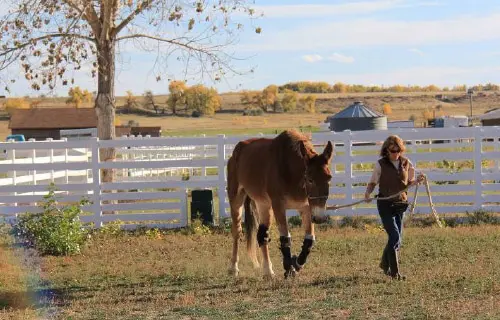
October 14, 2011
Re: Evaluation of Rock for Meredith Hodges
Chief complaint:
Acutely lame on left pelvic limb with muscle spasms and heat in the area of the left hip or stifle region. There is a possibility that he was injured while playing with his stablemate.
Medical history:
Rock was acquired in December 2010 with a chronic pelvic fracture on the right side. It that time he was unable to use the right hind limb other than to circumduct the leg when walking. Since that time he has undergone extensive rehabilitation and massage therapy in an effort to improve functional use of the limb and to increase muscling in the region. He also has a history of chronic laminitis in all four feet that have been managed with regular trimming, support boots on the front feet and shoes on the hind feet. Radiographs approximately 6 months ago showed significant rotation and thinned soles on both hind feet. He has been managed without any pain medications until recently, when he was treated with phenylbutazone for 9 days (3 days at 2 grams twice a day; then 6 days at 1 gram twice a day), which did provide pain relief at that time.
Observation:
Rock was in overall good body condition; although, there was pronounced back and especially right pelvic muscle atrophy. He has leg wraps on both forelimbs from mid-forearm distally to the pastern region. He has a hock wrap with padding on the left hind due to decubital sores. He also has superficial skin wounds at the left distal scapula and left elbow, which are treated with panalog.
He was alert but did not appear to want to readily move. He is able to stand squarely on all four limbs when Meredith provides prompts, but he stands with excessive carpal flexion and tends to unweight the right pelvic limb. There is occasional muscle fasciculations over the left mid-femoral region when standing still. He has a reported history of possible shivers and/or stringhalt.
Gait evaluation:
Rock moves slowly and carries the left hind limb to the mid-line of his body in an effort to unweight the right pelvic limb. There is a severe grade 4/5 lameness on the right fore with a noticeably shortened cranial swing phase. Moderate lameness is also noted in the left forelimb. He is unwilling to completely extend either carpus while walking. He is able to navigate a 10-foot circle in either direction but does not have confident pelvic limb placement or motion. He is reluctant to back up and is able to only do 1-2 steps with prodding.
Physical examination:
There is moderate muscle atrophy present in the cervical region with moderate stiffness in lateral bending at all cervical vertebral levels. No signs of pain, inflammation or muscle hypertonicity are noted in the neck, wither or trunk regions. The wither region is well muscled and has good tone throughout. Palpation of the forelimbs reveals severely hypertonic and over-developed extensor muscles of both forearms (antebrachium), relative the flexor muscle group. This is in response to him unloading the digital flexor tendons (normal antigravity muscles) and secondarily overloading the extensor muscles (not used to being antigravity muscles); likely due to an acute about of laminitic pain. There is mild heat and mild digital pulses in both front feet.
Rock has severe generalized stiffness throughout his thoracolumbar spine. There is restricted motion at the lumbosacral and sacroiliac joints; although, it is difficult to fully assess due to the presence of pronounced, periodic bone crepitus radiating from the pelvic region, which is likely due to an unstable or un-united chronic fracture site. The right pelvic region has severe muscle atrophy, but no obvious signs of localized pain or bony instability. The left and right pelvis and femur have readily palpable lateral bony landmarks with no pain localized to the bony prominences. There is normal tail tone and perianal reflexes; indicative of normal innervation in the region.
There is a 6-cm wide fibrotic band extending along the cranial margin of the left biceps femoris muscle in the pelvic region, but other muscles on the left side palpate normally other than having moderate atrophy. There is a region of heat and mildly edematous tissue about 10 cm wide and 30 cm long over the acetabular and greater trochanter regions on the left side. Overall muscle tone is good in the thigh region on both sides. Rock is willing to left his right hind limb and allow very gentle passive joint motion at his hip joint. No crepitus or pain was induced. He was not willing to lift the left hind limb to allow assessment of passive joint motion due to reluctance to fully weight bear on the right hind.
Assessment:
- Possible soft tissue injury to left hip region – secondary shifting of weight to forelimbs and exacerbation of chronic laminitis
- Acute bout of laminitis and pain – secondary compensation with his forelimb muscles
- Chronic right pelvic fracture and secondary muscle atrophy
Treatment goals:
- Reduce laminitis pain and continue to manage chronic foot problems
- Strengthen the pelvic muscles to help stabilize the chronic pelvic fracture
- Improve trunk mobility to support core stability and transfer of weight between the fore and hind limbs
Recommendations:
For the left hip region:
- Apply an ice pack over any areas of heat within the region, 1-2 times a day for 10-15 minutes, until the heat and pain is gone.
- Monitor muscle spasms and pelvic limb use on both sides.
For the laminitis:
- Apply cryotherapy to reduce pain and inflammation
- Apply bags of ice around the front feet for 20-30 minutes, 4-5 times a day for 1-2 days, and then 2-3 times a day as able until the pain is reduced.
- Place all four feet in specially-made wading pool filled with ice at the same dosage as above.
- Begin pain medications – Phenylbutazone plus Gastrogard for the next 7-10 days.
- Recommend repeat radiographs of all four feet to assess any changes from the prior radiographs and subsequent corrective hoof trimming. Depending on the status of his coffin bone position relative to the hoof wall, adding sole support with blue construction styrofoam or similar product to help specifically increase sole support would be indicated.
- If you are able to position Rock in lateral recumbency with someone restraining his head and preventing him from standing up cautiously, do passive range of motion on both front limbs in flexion, extension and mobilization of the coffin, pastern and fetlock joints. Massage of the hypertonic forearm muscles would be good also, if able to do in a safe manner.
For the chronic pelvic injury:
- Tail pull exercises to engage and stimulate pelvic muscle development. Apply axial traction for 2-3 seconds to activate gluteal muscles. Repeat cyclic loading-unloading for 20-30 repetitions, 1-2 times a day, for the next 4-6 months. May pull slightly toward the left or right sides to specifically active muscle groups on the left and right pelvic regions.
- If able, apply electrical muscle stimulation (or electroacupuncture) to the middle gluteal muscles bilaterally at a frequency of 2-5 Hertz, amplitude until you can see visible muscle contractions or to Rock’s tolerance. The goal is to increase muscle strength and size to help stabilize the pelvis.
- Apply superficial heat (heating pad) or deep heat (continuous therapeutic ultrasound) over areas of fibrosis to loosen connective tissue prior to massage.
- Continue vibrational massage (Thumper) over areas of muscle hypertonicity in the trunk and pelvic regions.
- Continue low-force chiropractic care of the pelvic region
For core stability:
- Recommend carrot stretches by directing his head toward the elbow and stifle regions with Rock stabilized up against a wall. Do 4-5 stretches to each site, 1-2 times a day, for 3-4 weeks. Make sure he does not lose his balance.
- Reinitiate proprioceptive training and ground pole exercises once the acute laminitic pain has been resolved.
Thank you for inviting me to consult on Rock. Please contact me if you have any questions.
![]()
Sincerely,
Kevin K. Haussler, DVM, DC, PhD
Diplomate, American College of Veterinary Sports Medicine and Rehabilaition
